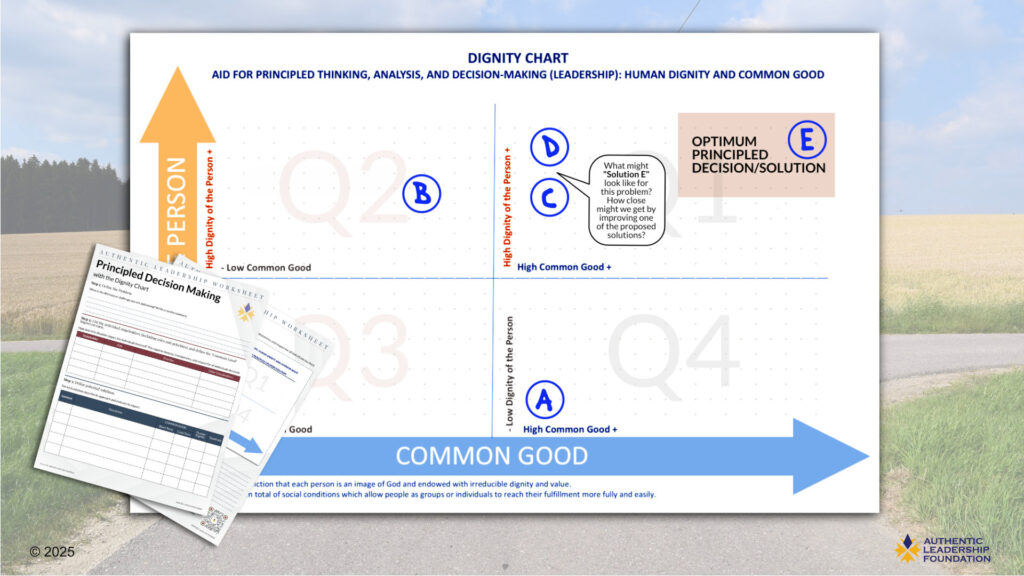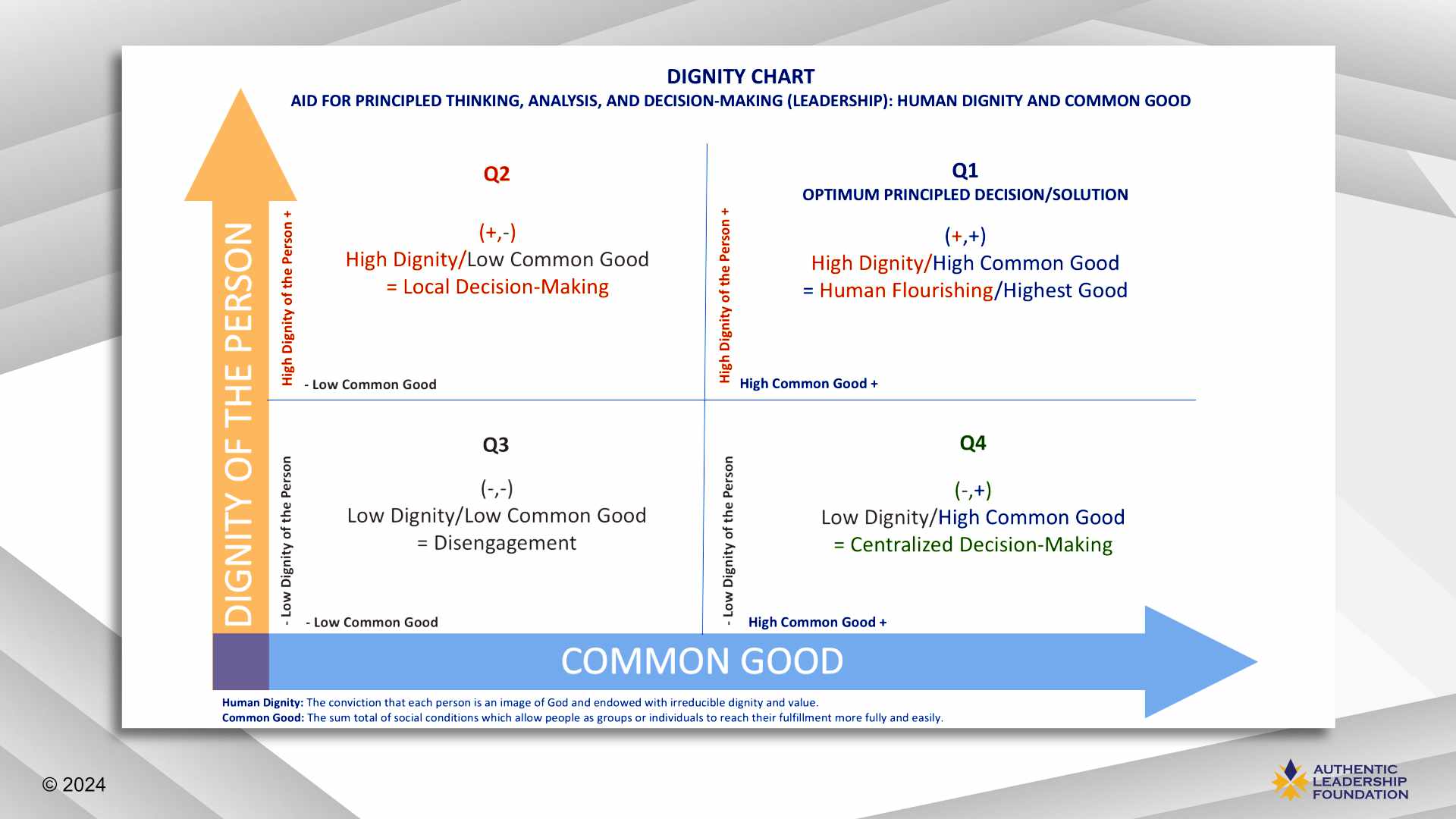Part 1 - The Dignity Chart: A Navigation Map for Principled Decisions
Originally developed in business and science, this quad chart has been adapted to prioritize principled decision-making and pursuing what is possible, rather than succumbing to human nature's tendency to follow a path of least resistance, just to move on to the next task. Principled solutions are better and help us get a little better in the process. Make sense? By using the Dignity Chart, we can bring our focus back to core principles—individual dignity and the common good—while finding practical solutions to real-world problems. The Dignity Chart creates a structured space to create principled solutions that result in more goodness, beauty, and growth for all of the individuals impacted by the solution.
Why Use the Dignity Chart?
For conscientious people, most decisions align naturally with their values (the challenge is values or what’s important to you can change with time/circumstances). But there are moments when conflicting values make principled decisions (principles never change) anything but easy. This is when the Dignity Chart truly becomes invaluable. It works as a kind of “navigation map,” offering a visual guide to help ensure that both individual dignity and the common good remain central to the decision-making process. You make decisions with principles and execute those decisions with your values.
How the Dignity Chart Works: Four Quadrants of Decision-Making
The Dignity Chart divides decision-making into four distinct quadrants, each representing different balances of human dignity and common good:
- Quadrant 1 (Q1): High Dignity / High Common Good
This is the ideal path, where both personal values and collective well-being align. Decisions made in this quadrant respect individual dignity while creating sustainable, trustworthy outcomes. - Quadrant 2 (Q2): High Dignity / Low Common Good
Here, decisions prioritize personal values, even if they might not immediately serve the broader group. This quadrant can represent standing firm on personal values that may come at a short-term cost. - Quadrant 3 (Q3): Low Dignity / Low Common Good
Disengagement sits here. Choices in this quadrant fail to benefit either individual dignity or the common good, often leading to avoidance of action or movement by inertia rather than intentional action. - Quadrant 4 (Q4): Low Dignity / High Common Good
This quadrant prioritizes group success, sometimes at the cost of individual dignity. Decisions here can achieve short-term wins but risk compromising long-term trust by individuals negatively impacted.
When the Dignity Chart Becomes Critical
The Dignity Chart offers clarity when we need it most: in ethical dilemmas, high-stakes decisions, and situations with no obvious solution. By keeping human dignity and the common good in balance, it helps us identify the path that not only works but is also worth taking.
Part 2 - The Dignity Chart Process in Action: Dora’s Dilemma
To see the Dignity Chart in action, consider the case of Dora Flowers. Dora, a year into her job at Pseudonym Solutions, has been asked to prepare a revised project bid for XYZ Company. Her supervisor, Jacqueline, has requested that she reduce the project timeline estimate from eighteen months to twelve, even though she knows twelve months is unachievable with their current resources. Dora’s discomfort grows as Jacqueline insists that this approach—promising an unrealistic timeline—is common in software consulting. The aim, she says, is to secure the contract, with the expectation that once the project begins, XYZ will likely agree to extensions rather than switch consultancies.
This situation puts Dora in a tough spot. Following Jacqueline’s directive would mean compromising her professional integrity and potentially misleading a client. Ignoring her request, however, could damage her relationship with Jacqueline and jeopardize her standing within the company. Using the Dignity Chart process can help Dora navigate this dilemma with a structured approach.
What is the dilemma or challenge you are addressing?
Write a concise summary of the problem:
Dora’s Dilemma: Dora is facing pressure to misrepresent a project timeline, which risks client trust and her own sense of
professional ethics.
How does this situation impact the individuals involved? This principle requires honesty, transparency, and respect for all individuals involved.
- For Dora, it means upholding her ethical standards and professional integrity.
- For the client (XYZ Company), it means setting realistic expectations and receiving a high-quality deliverable without undue stress or financial overruns caused by false promises.
- For the company (Pseudonym Solutions): Winning the bid, maintaining a good reputation, and fostering sustainable client relationships.
- Jacqueline (Supervisor): Senior staff member, pushing for an aggressive bid to secure the contract; represents company leadership but also a potential risk of compromising ethics.
Stakeholder | Role | Priorities & Impact |
| | |
| | |
| | |
| | |
To evaluate the situation thoroughly, we consider all proposed solutions, factoring in their likely short- and long-term impacts on the Common Good and Human Dignity.
- Solution A: Jacqueline’s Approach – Promise a Twelve-Month Timeline
Jacqueline’s solution prioritizes securing the bid with an unrealistic timeline. While the company may benefit financially in the short term, the client is misled and likely harmed, leading to frustration, possible financial overruns, and a damaged relationship.- Short-Term Common Good: High for the company (winning the bid); Low for the client (being misled).
- Long-Term Common Good: Low for both parties (damaged trust and reputation; deception).
- Quadrant: Q4 (Low Dignity / Low Common Good).
- Solution B: Maintain the Original Eighteen-Month Timeline
Dora could insist on the original, realistic estimate. This upholds transparency and respects client trust but risks making the bid less competitive for Pseudonym.- Short-Term Common Good: Low for the company (risk of losing the bid); High for the client (receives an honest and achievable timeline).
- Long-Term Common Good: High for both parties (fosters trust and sustainable collaboration).
- Quadrant: Q2 (High Dignity / Mixed Common Good).
- Solution C: Propose a Compromise Timeline (e.g., Fifteen Months)
Dora could suggest a middle-ground timeline that is ambitious yet achievable. This balances competitiveness with realism and preserves honesty with the client.- Short-Term Common Good: Medium for the company (more competitive bid); Medium-High for the client (timeline is challenging but achievable).
- Long-Term Common Good: High for both parties (aligns trust with successful outcomes).
- Quadrant: Q1 (High Dignity / High Common Good).
- Solution D: Seek Mediation or Guidance from a Colleague or Senior Team Member
Dora could involve another trusted team member to help advocate for a principled solution. This builds consensus and ensures the decision reflects shared values.- Short-Term Common Good: Medium for the company (depends on the outcome of mediation); Medium-High for the client (avoids being misled).
- Long-Term Common Good: High for both parties (reinforces trust and values).
- Quadrant: Q1 (High Dignity / High Common Good).
For each solution, describe its approach and evaluate its impact.
Solution | Description | Short-Term Common Good | Long-Term Common Good | Human Dignity | Quadrant |
|
|
|
|
|
|
|
|
|
|
|
|
|
|
|
|
|
|
|
|
|
|
| |
Solutions C & D align with Quadrant 1 (High Dignity, High Common Good). What might a "solution E" look like (achieving the upper right of Quadrant 1)? How close might we get to a "solution E" by improving one of the proposed solutions? By standing for honesty and transparency, Dora can both maintain her professional integrity and foster a trustworthy, sustainable client relationship for Pseudonym.
A Candid Look at the Risks
Taking a stand in Quadrant 1, however, is not without risks. Dora’s approach could lead to tension with Jacqueline, or even to the loss of the bid if XYZ selects another consultancy with a more aggressive timeline. The stress of advocating for her principles in a high-stakes scenario could also impact her well-being if support from within the firm is limited. But by choosing this path, Dora prioritizes long-term relationships and her own professional integrity, both essential for sustained success.
While there are no guarantees, the Dignity Chart offers a practical framework for principled decision-making. By balancing human dignity with the common good, it gives individuals a structured path to make ethical choices, even when facing conflicting values. The Dignity Chart isn’t just about decisions; it’s about cultivating a process that leads to sustainable growth, trust, and ultimately, a little better version of ourselves every day.
Download the Worksheet (includes this guide) and give it a try!



